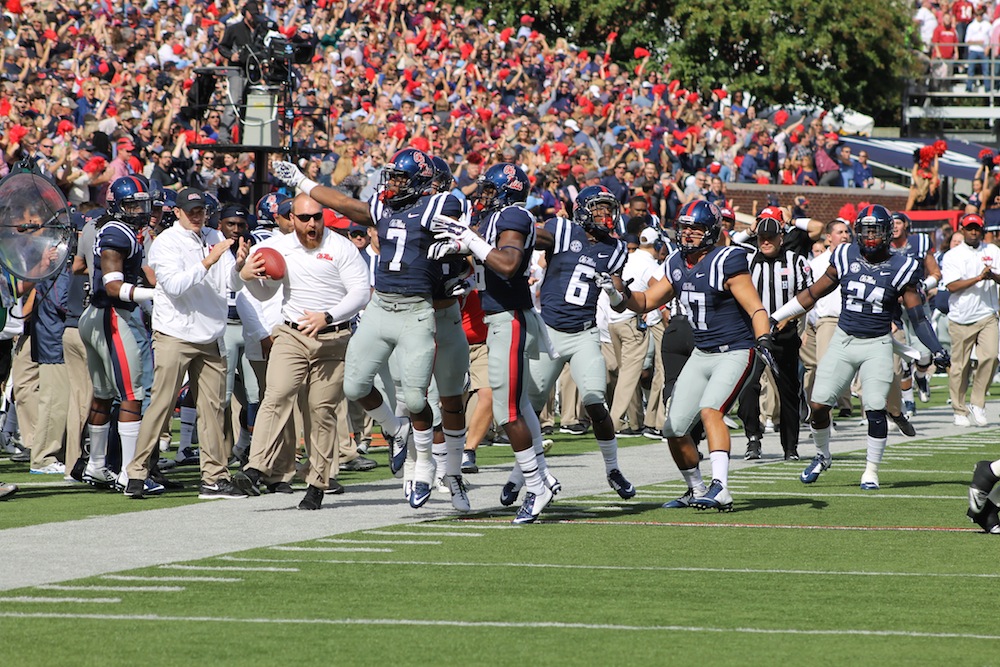Headlines
Mitchell: College Football is Growth Industry in Mississippi

If asked to name an overlooked economic force in Mississippi, an answer would be football.
College football to be precise.
Now that the season (except for bowls) has ended and it has become clear that Ole Miss will not meet Mississippi in the first-ever national championship playoffs (which at least for a week or two loomed as an outside possibility), we can take our eyes off of the turf and peek into the cash register.
The athletic budget at the University of Mississippi was $73.4 million last year. Of that, 94.8 percent came from ticket purchases, donations, sales of broadcast rights and licensed merchandise. The rest came from student fees, the value of school-provided scholarships and even federal funds for athletes in Work-Study programs. (Yes, strictly speaking, college football contributes to the national debt.)
 The athletic budget at Mississippi State University during the same year was $62.8 million, of which a greater portion, 95.2 percent, was self-generated.
The athletic budget at Mississippi State University during the same year was $62.8 million, of which a greater portion, 95.2 percent, was self-generated.
There are, of course, six additional public universities in Mississippi, lots of community colleges and private colleges with sports teams.
Along with the two Southeastern Conference schools, the other athletics programs cause a lot of money to be moved around. And it is the movement of money that determines the level of economic vitality of a state or region.
The figures, gleaned from USA Today and other sources, do not, upon first impression, indicate Mississippi is out of line.
Ole Miss and State, respectively, were 36th and 49th nationally in the size of their budgets for all athletics (not just football) last year. Even if combined, the accounts of the state’s two largest schools wouldn’t approach the $166 million figure for Texas, $149 million for Wisconsin or $144 million for SEC rival Alabama.
But these things are best examined in context.
For example, in raw numbers there are 225 NFL players from California and a mere 32 from Mississippi, which makes us 16th overall. The more accurate view is per capita. Based on Mississippi’s 3 million residents and California’s 38 million, Mississippi moves up to third in the nation in producing professional football players. (Louisiana is ahead of us, but they get to count Peyton and Eli even though most of us consider them Mississippians.)
 Similarly, examining the budgets of both SEC schools in Alabama in context shows there’s some room for growth in Mississippi — but not much.
Similarly, examining the budgets of both SEC schools in Alabama in context shows there’s some room for growth in Mississippi — but not much.
Sorry to do this to you, but follow the math: Add Auburn’s $103.6 million athletic budget to ’Bama’s and the two received and spent $247.6 million. That’s $52 per Alabaman. Combine the Ole Miss and MSU budgets and divide by Mississippi’s population and it shows major college athletics churning about $49 per capita.
Pretty even.
Got to factor in stadium size, too. Mississippi State just expanded Davis-Wade to 63,337 seats. Vaught-Hemingway holds 60,580, but expansion to 70,000 has started. Auburn’s stadium holds 87,500 and ’Bama’s holds 102,000. So those schools have 65,500 more home game tickets to sell than State and Ole Miss combined.
And the Rebels and Bulldogs still hang with them — on the field and in proportional budgets, too.
On sports pages last week was the sad story that the University of Alabama-Birmingham is ending its football program. The reason given was “fiscal considerations,” detailed as the university having to come up with $20 million of the $30 million football budget.
For smaller schools — those that don’t have TV contracts or pack fans in the stands — fielding a team is expensive. Jackson State had only a $6.4 million budget last year, but 60 percent of those dollars came in subsidies. Mississippi Valley’s budget was $4.4 million, but as at UAB, ticket sales and other revenue generated only about a third of those dollars.
 For the “bigs,” though, big is getting bigger.
For the “bigs,” though, big is getting bigger.
In 2009, the Southeastern Conference (the paymaster for broadcast rights and such) distributed $166 million to 12 teams. This year, the SEC, which has grown to 14 teams, will distribute $310 million — and another bucket of cash will come from the new SEC Network on ESPN.
There’s no earthshaking point to be made here. The rich are getting richer and the poor are struggling in all aspects of the economy.
But whatever Mississippi can do to support athletics should be done. Not many brick and mortar industries or employers generate the financial activity that State and Ole Miss football do.
Hotty Toddy. More cowbell.
Maybe — MAYBE — one day we’ll see university programs in this state so prosperous they support or help support other university functions.
It could happen.
Charlie Mitchell is a Mississippi journalist and associate dean of the Meek School of Journalism and New Media. Write to him at cmitchell43@yahoo.com.


























